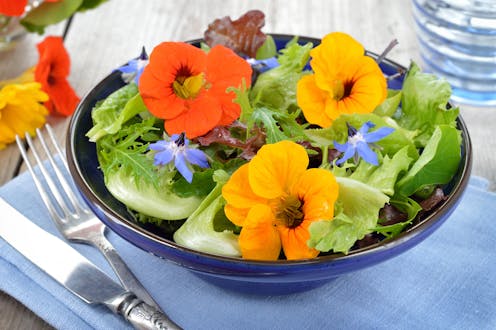
When we think of food in the past, it is often images of Henry VIII with a table groaning with meat dishes that springs to mind. But in fact our ancestors knew more about the health benefits of eating salads – normally thought of as a cold dish of herbs or vegetables – than we might think.
By looking back to the sustainable self-sufficiency of the past, we find there is a lot we can learn about the variety of the historical salad dish, which costs next to nothing, has no carbon footprint and might even be beneficial to our health.
The diarist, writer, and gardener John Evelyn (1620-1706) pursued his interest in salads in the mid-to-late 17th century. His model both defined the dish very broadly and showed how you could live on home-grown salads all year round.
To Evelyn, the ideal kitchen garden was full of vegetables and fruits that could be grown simply and in great variety. Evelyn even published a whole guide to growing and preparing salads, Acetaria, A Discourse on Sallets in 1699. The words “sallet” came into English from the French “salade” in the 1300s and was in common use by the 1600s.
In Acetaria, Evelyn promotes a low-meat diet, insisting that those who live on herbs and roots live to a ripe old age. He cites classical philosophy to back up his arguments about the “the Wholeſomness of the Herby-Diet” – citing Plato and Pythagoras as examples of great thinkers who banished “flesh” from their tables. Evelyn was not interested in converting people to vegetarianism as such, declaring:
But this is not my Buſineſs, further than to ſhew how possible it is by so many instances and examples, to live on wholeſome vegetables, both long and happily.
In the past year, gardening and growing vegetables has enjoyed a resurgence as a family-friendly, outdoor pastime that can also help ease concerns over food shortages. While becoming totally self-sufficient is unlikely, Evelyn’s Acetaria has some tips that the green-fingered grower can use to feed their families and some advice that could help expand their harvests in an unlikely way.
The gardener’s year
The centrality of salads to the diet in Evelyn’s manifesto is underpinned with the verse from Acetaria:
Bread, Wine and wholſome Sallets you may buy,
What Nature adds beſides is Luxury.
While the rhyme refers to buying salads, Evelyn points out that such plants are easy to grow, have no fuel requirement in their preparation, are near at hand and importantly easy to digest.

And nature aids all sorts of things, as highlighted in another work of Evelyn’s, Directions for the Gardener, written about his garden at Sayes Court in southeast London. This book contained helpful hints and tips for growing produce for the kitchen table. It’s not just the expected salad items such as cucumber and lettuce that Evelyn remarks on though. He offers daisies, dandelions and docks as part of the bounty, as well as cowslips (a type of primrose). These and many other plants that even flourish on compost heaps and waste ground could help the gardener be more self-sufficient – and at no real cost.
Many of the “weeds” have to be picked at the optimum time, and sometimes the roots and stems are boiled to remove the bitterness. In any case, early moderns were wary of raw vegetables because it was believed that if eaten in too great a quantity they could upset the body. But the key point is that he has a much broader definition of what might be included in the salad family, such as the kind of foraged plants that are making a come-back in some high-end restaurants.
Some of what Evelyn recommends were new spins on familiar ingredients. So why not pickle the seed-pods of a radish to make an attractive addition to your salad dish rather than just using the root? Or cook the stalks of a turnip (before it runs to seed) and eat them boiled and covered in butter, like asparagus.
A salad “fitted for a City Feast”
This is a flamboyant recipe that Evelyn gives us that upends our view of what a salad can be.
Ingredients
Blanched almonds sliced, and soaked in cold water
Pickled cucumbers
Olives
Cornelians (a kind of cherry which Evelyn claims when pickled can pass for an olive)
Capers
Berberries (barberries)
Red-Beet (beetroot)
Nasturtium buds
Broom
Purslane stalks
Samphire
Ash keys
Walnuts
Pickled mushrooms
Raisins of the Sun
Citron and Orange peel
Corinth (currants) well cleansed and dried
Method
Chop all these ingredients, add in some roasted maroons (sweet chestnuts), pistachios, pine-kernels, lots more almonds, and decorate with candied flowers, and sprinkle with rose water. Accompany with a side dish of pickled flowers in vinegar.
The message of Evelyn’s book is to use what nature provides. The medicinal garden (called the apothecary or physic garden) brought into sharp focus the beneficial properties of various plants, which they thought able to cure all sorts of complaints. Evelyn would have been proud to see a nation of gardeners and cooks today taking up this self-sufficiency that was so natural to him back in the 1600s. Something for us to reflect on as we enter another new year.
The authors do not work for, consult, own shares in or receive funding from any company or organisation that would benefit from this article, and have disclosed no relevant affiliations beyond their academic appointment.












